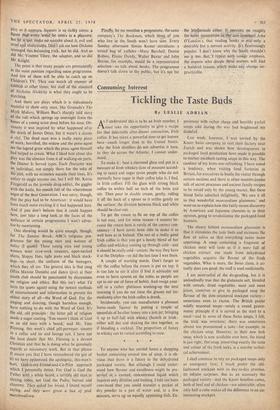Consuming Interest
Tickling the Taste Buds
By LESLIE ADRIAN
AIunderstand this is to be an Irish number, I ,must take the opportunity to give a recipe for that delectable after-dinner concoction, Irish coffee. It has taken a powerful time to get known here—much longer than in the United States; why the Irish distillers do not advertise it here, as they do across the Atlantic, I cannot under- stand.
To make it : heat a stemmed glass and put in a measure of Irish whiskey (size of measure accord- ing to taste) and sugar (even people who do not normally have sugar in their coffee take it, I find, in Irish coffee). Fill the glass with strong black coffee to within half. an inch of the brim and stir. Then pour in double cream, gently, rolling it off the back of a spoon so it settles gently on the surface; the division between black and white should be clear-cut.
To get the cream to lie on top of the coffee is not easy, and for some reason—I suspect be- cause the cream .here is rarely of the correct con- sistency—I have never been able to make it as well here as in Ireland. The test of a really good Irish coffee is that you get a heady blend of hot coffee-and-whiskey coming up through cold—and it should be really cold—cream; the way they have it at the Dolphin—or did the last time I was there.
A couple of warning words. Don't forget to stir the coffee before the cream is put on top; it is too late to stir it after (I find it advisable not even to have spoons on the table, as people are apt to stir out of force of habit). And resign your- self to a rather glutinous washing-up the next morning if you do not rinse the glasses out im- mediately after the Irish coffee is drunk.
Incidentally, you can manufacture a pleasant home-made liqueur by putting a couple of spoonfuls of heather honey into a jam jar, bringing it up to half-full with whisky (Scotch or Irish: either will do) and shaking the two together, as if blending a cocktail. The proportion of honey to whisky can be varied according to taste.
To anyone .who has carried home a shopping basket containing several tins of soup, it is ob- vious that there is a future in the dehydrated packaged variety. But although I could under- stand how flavour and excellence might be pre- served in a canned, concentrated liquid which requires only dilution and heating, I had not been convinced that you could transfer a packet of dry powder to a pan of water and, in a few minutes, serve up an equally appetising dish. Ex- periences with rather cheap and horrible packet soups sold during the war had heightened my disbelief.
Last week, however, I was invited by the Knorr Swiss company to visit their factory near Zurich and was shown how developments in packaged food production have made it possible to market excellent-tasting soups in this way. The candour of my hosts was refreshing. 1 have noted a tendency, when visiting food factories in Britain, for executives to bustle the visitor through certain sections and there is often mumbo-jumbo talk of secret processes and ancient family recipes to be mixed only by the young master. But these bland Swiss admitted delightedly, 'We owe it all to that wonderful monosodium glutamate,' and. went on to explain how this fairly recent discovery by American and Japanese chemists is, in their opinion, going to revolutionise the packaged-food business.
The theory behind monosodium glutamate is that it stimulates the taste buds and increases the flow of saliva so that everything tastes more appetising. A soup containing a fragment of chicken meat will taste as if it were full of chicken extract; one made from dehydrated vegetables acquires the flavour of the fresh vegetables. What is more, the Swiss claim, it ac- tually does you good; the stuff is used medicinally.
I am mistrustful of the do-gooding, but it is undoubtedly true that the glutamate salt, blended with cereals, dried vegetables, meat and meat juices, contrives to give to packaged, soup the flavour of the slow-simmered stockpot variety— sometimes even to excess. The British prefer mildly seasoned soups—surely a sound gastro- nomic principle if it is served as the start to a meal—and in sonic of these Swiss soups, I felt, the trick was overdone; there was sometimes almost too pronounced a taste—for example, in the chicken soup. However, in their new leek soup, which is now available over here, the blend is just right; this soup, preserving exactly the taste and colour of the fresh leeks, is a notable techni- cal achievement.
I shall continue to rely on packaged soups only as emergency fare; I much prefer the old- fashioned stockpot with its day-to-day promise, its infinite surprises. But as an accessory the packaged variety—and the Knorr bouillon cubes, both of beef and of chicken—are admirable; often only half a cube makes all the difference to an un- interesting stockpot.














































 Previous page
Previous page